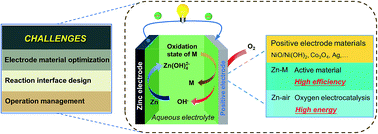Achieving high energy density and efficiency through integration: progress in hybrid zinc batteries
Abstract
Rechargeable zinc–air batteries, with a high theoretical energy density and intrinsic safety, have attracted significant research interest and have seen great development in recent years. However, hindered by the theoretical potential of 1.65 V, it is difficult to further increase the working voltage. In contrast, some conventional Zn–M batteries (M represents transition metal or metal oxide/hydroxide) with low capacities can exhibit high working voltages due to the redox couples with high potentials (e.g., Zn–Ni battery). Thus, combined with Zn–air and Zn–M batteries, hybrid Zn batteries that can achieve both high energy density and efficiency are proposed by using the electrode materials to link these two kinds of reactions. In this report, three types of hybrid Zn batteries (i.e., Zn–Ni/air, Zn–Co/air, and Zn–Ag/air batteries) are introduced in detail, based on the positive electrode materials. The positive electrode materials and the achieved electrochemical performance are summarized, and potential applications in electric vehicles and wearable electronics are discussed. Moreover, perspectives on the electrode material optimization, reaction interface design, and operation management are provided. This work shines a timely spotlight on hybrid Zn batteries and may pave the way for the further development of novel electrochemical energy storage systems.



 Please wait while we load your content...
Please wait while we load your content...